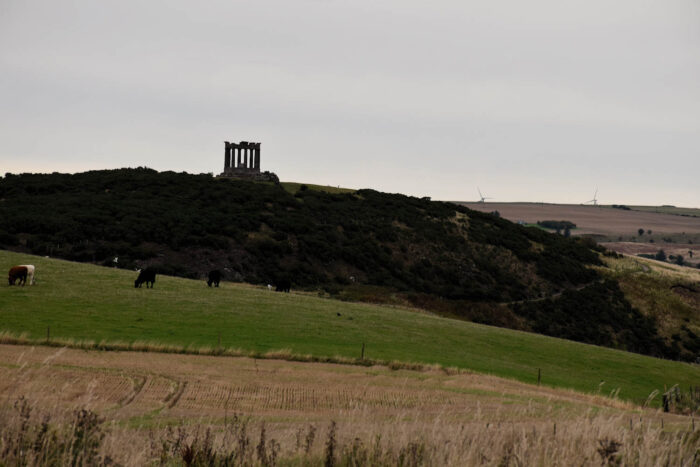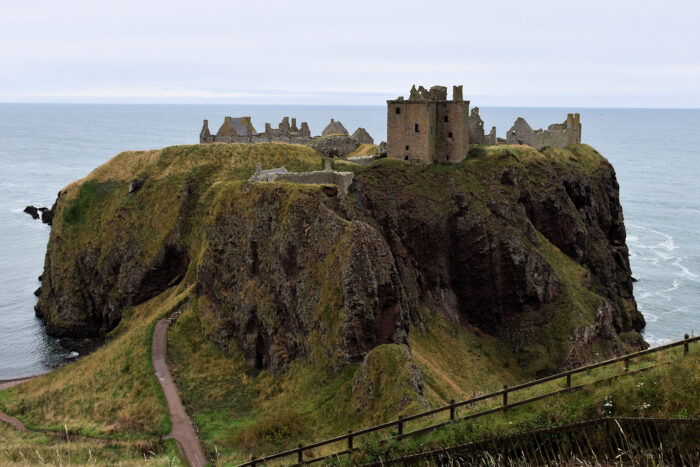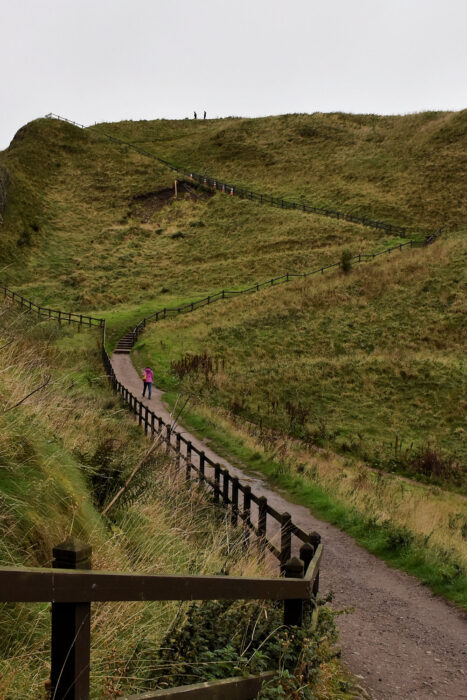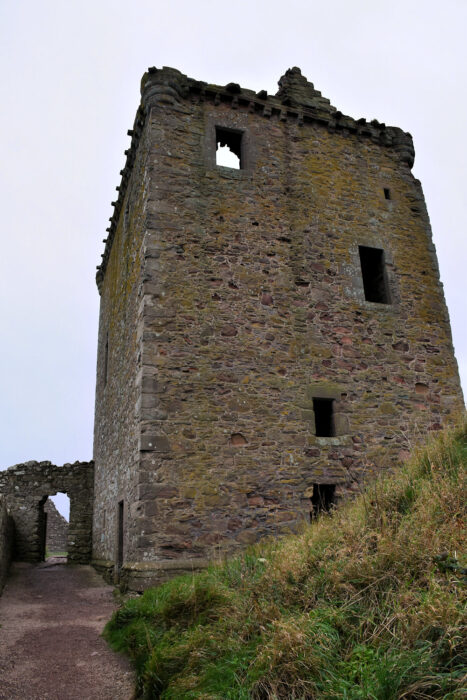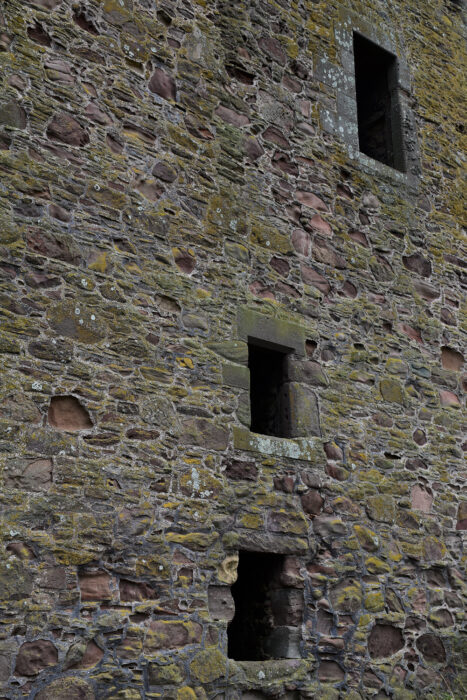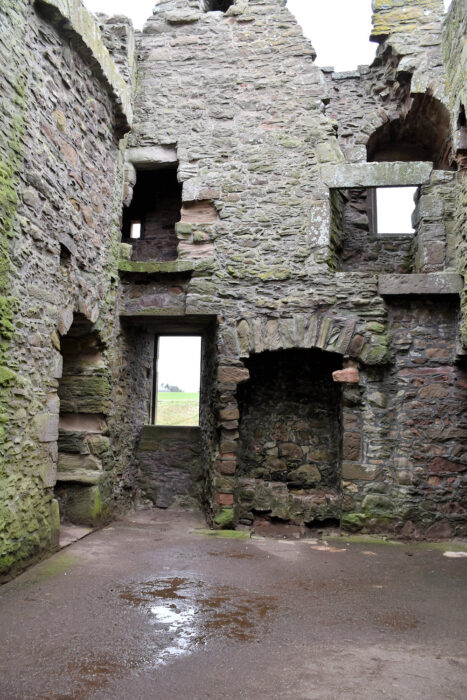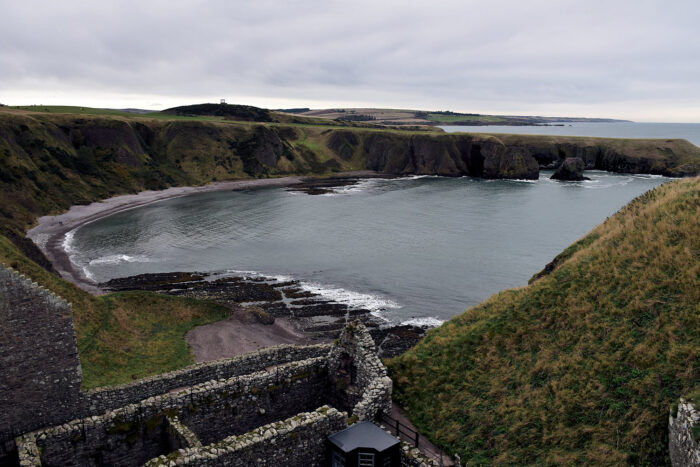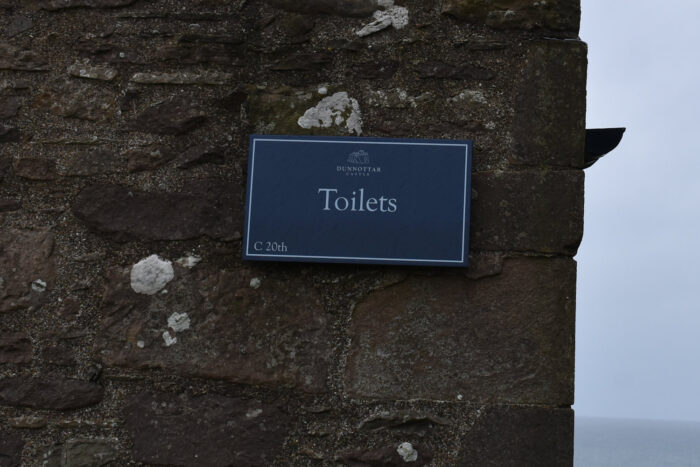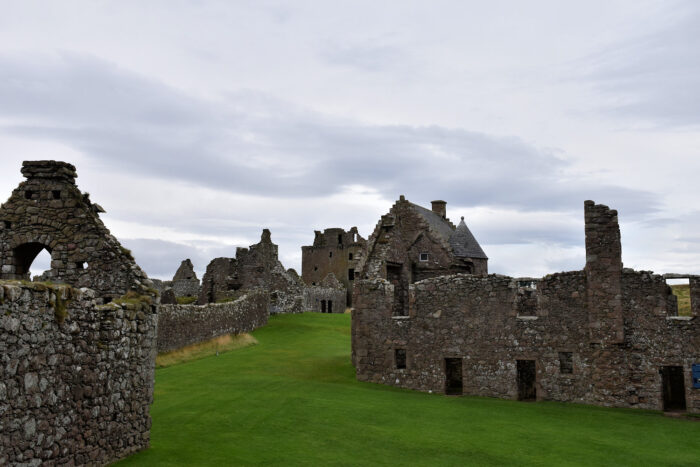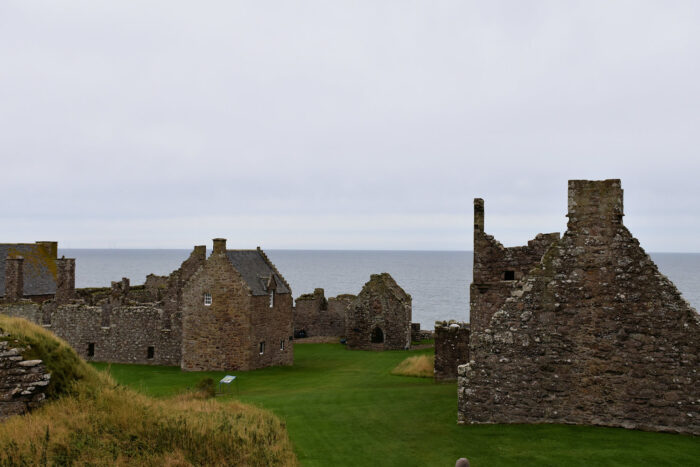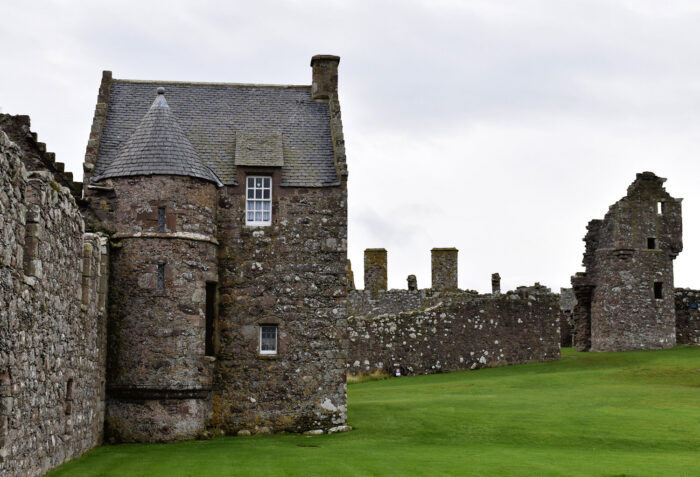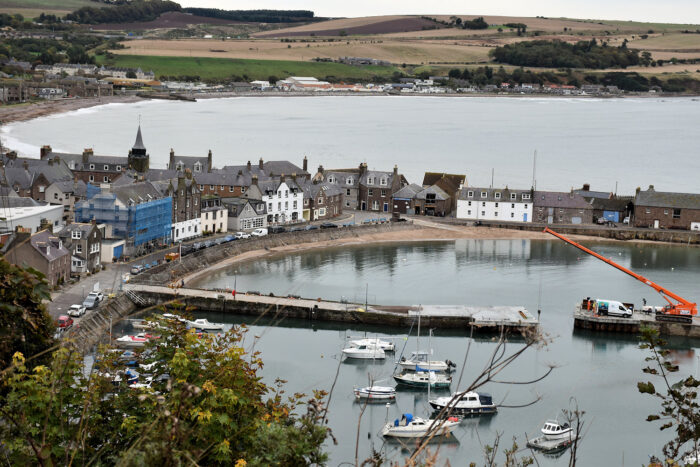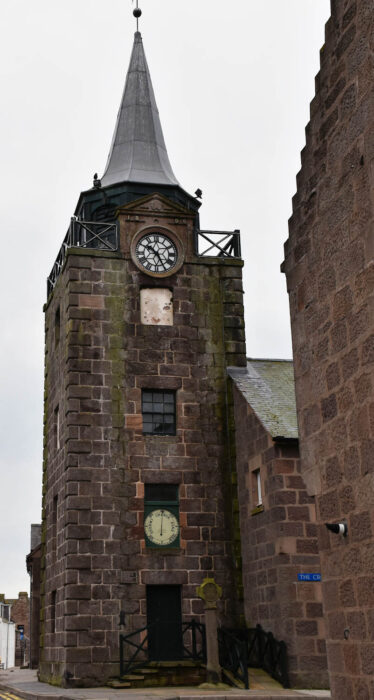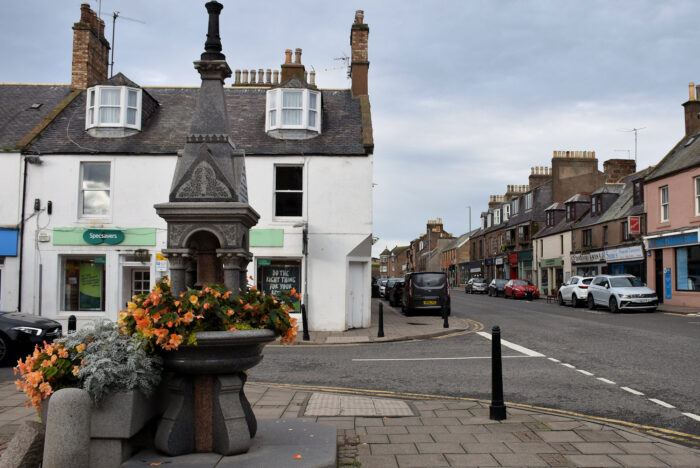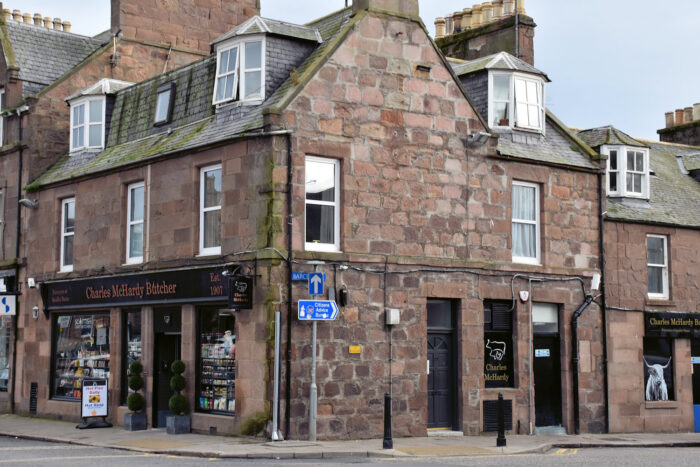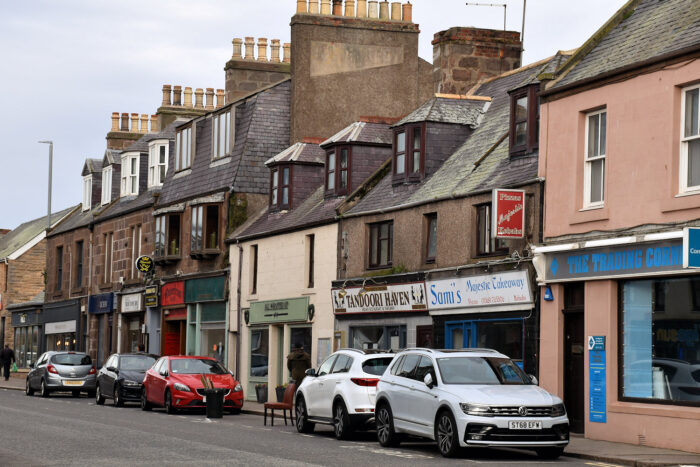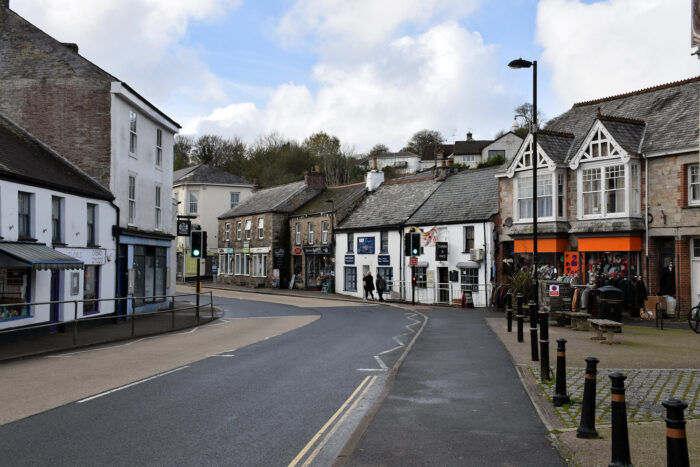If you’re going to Dunnottar Castle by bus, you have a choice of ways to get there. There’s a bus stop on the main road just around from the entrance road or you can get off in the nearby town of Stonehaven and take the forty-minute walk around the cliffs. OK I’m joking.
Of course you’ll do the walk around the cliffs. It has the best views.
And random Greek temples on the hillside.
Now this is the best view. It is worth the climbing the hill and walking around the cliffs just to see this. Really.
(And the previous photo? It’s the war memorial.)
Also a great view. Although you might want to pause here and wonder how to get from THIS hill to THAT hill, because it’s about to become an important issue.
The steps start at the top of the peak in the top left (you might be able to make out the handrails) and come down the slope and then turn and come down more and then turn again and become the path up to the gate.
Most of the buildings on the site are from the 16th & 17th century, but that keep is late 14th century.
The great hall. (Perhaps I should add for the less-castlely inclined, the great hall is where everything happened, so there’s basically the hall, private chambers and the utilitarian rooms.)
And a great view.
The site is well laid out. It’s relatively easy to get around and find things. There’s a card given out at the entry that tells you where everything is. There are discreet panels with information at strategic points, that give tell you what each building is, when it was built and any interesting points.
But there didn’t seem to be, at any point, anywhere, a summary of the site’s history, and that’s important in giving context. Otherwise, it’s just a bunch of stones. Near the entrances, there’s a nice building full of information panels but it’s almost all about the about the Honours of Scotland (a lot, I wasn’t sure what was important to read so I didn’t read any).
If you’re interested:
The Honours of Scotland, informally known as the Scottish Crown Jewels, are regalia that were worn by Scottish kings and queens at their coronations. Kept in Edinburgh Castle, they date from the 15th and 16th centuries, and are the oldest surviving set of crown jewels in the British Isles. . . . The Honours were last used at a coronation in 1651, when Charles II was crowned at Scone. As Oliver Cromwell had invaded Scotland the previous year, and Edinburgh Castle had surrendered to his army that December, the Honours could not be returned there. The English Crown Jewels had already been melted down and struck into coins by the Commonwealth. With Cromwell’s army fast advancing on Scone, in June 1651 the Privy Council decided to place them at Dunnottar Castle in Kincardineshire, the family seat of the Earl Marischal, the custodian of the Honours.
They were brought to Dunnottar, hidden in sacks of wool, and Sir George Ogilvie of Barras, lieutenant-governor of the castle, was given responsibility for its defence. In November 1651, Cromwell’s troops called on Ogilvie to surrender, but he refused. During the subsequent blockade of the castle, the removal of the Honours of Scotland was planned by Elizabeth Douglas, wife of Sir George Ogilvie, and Christian Fletcher, wife of James Granger, minister of Kinneff Parish Church. Two stories exist regarding the removal of the Honours. Fletcher stated in 1664 that over the course of three visits to the castle in February and March 1652, she carried away the crown, sceptre, sword and scabbard hidden amongst sacks of goods. Another account, given in the 18th century by a tutor to the Earl Marischal, records that the honours were lowered from the castle onto the beach, where they were collected by Fletcher’s servant and carried off in a creel of seaweed.
Wikipedia
There’s even a model of the castle site in 1651, with all the bits marked and a description of what they were. But beyond 1651? I couldn’t see anything. If the keep was the first stone building, I guess there was a wooden castle-type building before that, built for someone, another earl guy?, for some reason. Then in the 16ht/17th century there was some major redevelopment, presumably to make it more comfortable and up-to-date.
Then in the chapel it says the first chapel burnt down, with a garrison of English soldiers inside, by William Wallace in 1297. Well that came out of nowhere.
The other thing that was missing: that complex on the buildings on the left, there’s nothing that says what it is. There’s information about individual parts, when they were built, what they were used for. There’s a dining room, a drawing room, and a suite for the earl and countess around a courtyard, so I assume it’s the main (17th century) residence. But I had to piece this together.
Fireplace in the earl’s suite.
The Silver House on the left (maybe for storing the silver) and a residence on the right
The pends, and the way out.
I should add the going UP the stairs was probably easier than coming down. They are wide and shallow, so easy to take in your stride (literally).
I stopped for lunch and had an offer to help with my burger (an Angus burger with bacon, haggis & salad for those interested).
Then I stopped in the nearby town, Stonehaven. The harbour.
And an interesting clock tower.
The town itself is built around a market square, which is now a car park.

